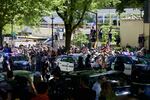Portland Police have temporarily suspended the use of flash-bangs after reports the devices caused injuries when police used them during a Patriot Prayer rally and counter-demonstration earlier this month.

Right-wing Patriot Prayer, Proud Boys and counter-protesters shout at one another from across a street in Downtown Portland.
Ericka Cruz Guevarra / OPB
OPB's "Think Out Loud" spoke with Charlie Mesloh, a professor at Northern Michigan University, to find out more about the devices and how they are used. Mesloh studies less-than-lethal weapons and their use by law enforcement. He is a former police officer and founded the Weapons and Equipment Research Institute at Florida Gulf Coast University.
Here’s what you need to know about flash-bangs, how they are used and how they are regulated:
What Is A Flash-Bang?
A flash-bang is a non-lethal explosive device that is often used by police to stun and disorient people. The devices make a loud noise and emit a bright flash of light when they explode, temporarily blinding and deafening people nearby. They are also known as stun grenades.
How Many Different Types Of Flash-Bangs Are There?
There are several different types and brands of flash-bangs, Mesloh told "Think Out Loud." Some flash-bangs are designed to be thrown by officers into buildings before the officers enter the building. Others are put into buildings on the end of a long pole and detonated by pulling a cord.
Police also use aerial flash-bangs, which are meant to be fired above a crowd and are typically used for crowd control. These devices are meant to fly 20 to 30 feet over people’s heads, Mesloh said, and can travel anywhere from 50 to 300 meters depending on the type used.
Portland police have said they used 40 millimeter "aerial distraction" devices during the Patriot Prayer rally and counter-demonstration on Aug. 5.
What Were Flash-Bangs Originally Designed For?
Some types of flash-bangs evolved from concussion grenades. Concussion grenades created a large blast and pressure wave and, unlike modern flash-bangs used by police, were often lethal.
Aerial flash-bangs were developed based on the concept of bird bangs, which were used to scare birds away from unwanted areas.
How Common Are They?
Law enforcement officers in the U.S. use flash-bangs dozens, if not hundreds, of times every day, Mesloh said.
Mesloh believes the devices save lives by allowing police officers to stun opponents before entering a building. If officers didn’t use flash-bangs, Mesloh estimates the number of police shootings would at least double. That’s because the devices help officers avoid confrontation when entering a building by stunning the people inside, he said.
How Are They Regulated?
There is very little regulation for the use of flash-bangs, Mesloh said. Training requirements vary agency by agency. And many agencies don’t test their equipment themselves before using the devices, he said.
“Really, there is no regulation on it at all,” Mesloh told "Think Out Loud." "That was kind of the whole reason I set up my institute. There were no standards whatsoever in less lethal.”
The lack of testing before use is concerning, Mesloh said. It's not clear if the devices are tested in urban areas. When flash-bangs are fired on city streets, he said, wind currents and down drafts can affect the devices' trajectories in ways officers may not expect.
How Often Are People Injured By Them?
A 2015 ProPublica investigation found that between 2000 and 2015, at least 50 Americans were seriously injured, maimed or killed by flash-bangs. ProPublica estimated this was just a fraction of total injuries, since few records are kept on flash-bang usage.
But, Mesloh said, that is relatively few injuries based on how many times officers use flash-bangs in this country.
With the proper usage and training, Mesloh believes that flash-bangs are an important tool. But, he said, the devices are expensive and that may mean practice with them is limited.
"I think that officers should be trained properly if they are going to use this technology," he said. “I wonder, when an officer is handed a grenade launcher and a bag of shells ... have they ever really practiced firing it down a city street? My guess is no.”
To hear more from “Think Out Loud’s” conversation with Charlie Mesloh, click the “play” button at the top of the page.
